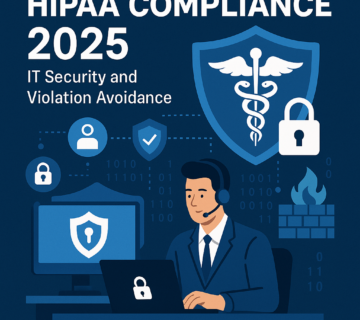Critical Google Security Flaw Exposes Millions of Users’ Phone Numbers Through Brute-Force Attack
🎙️ Dive Deeper with Our Podcast!
Critical Google Security Flaw Exposes Millions of Users’ Phone Numbers Through Brute-Force Attack
👉 Listen to the Episode: https://technijian.com/podcast/google-phone-number-vulnerability-legacy-system-exploitation/
Subscribe: Youtube | Spotify | Amazon
A devastating security breach in Google’s authentication infrastructure has been discovered, potentially compromising the phone numbers of millions of Google users worldwide. This critical vulnerability demonstrates how legacy systems can become dangerous security liabilities when left unpatched.
The Discovery That Shocked the Cybersecurity Community
Security researcher Guru Baran from BruteCat unveiled a sophisticated attack vector that exploited Google’s forgotten username recovery system. The vulnerability specifically targeted Google’s No-JavaScript recovery form—a legacy endpoint that most users never knew existed but posed an enormous security risk.
The attack methodology was surprisingly elegant in its simplicity yet devastating in its effectiveness. Cybercriminals could systematically extract complete phone numbers from any Google account using nothing more than a display name and some technical ingenuity.
How the Google Phone Number Extraction Attack Worked
Step 1: Display Name Harvesting
Attackers began by obtaining target Google account display names through Looker Studio document transfers. This initial step required zero interaction from victims, making the attack completely undetectable during its early stages.
Step 2: Password Recovery Exploitation
The second phase involved initiating Google’s standard forgot password process to retrieve masked phone number hints. These hints typically showed only the final digits of associated phone numbers, creating what appeared to be a security barrier.
Step 3: Systematic Brute-Force Enumeration
The final step utilized a custom-built tool called “gpb” (Google Phone Brute-forcer) to systematically test phone number combinations against known display names. This process could verify whether specific phone numbers belonged to particular Google accounts.
Technical Sophistication Behind the Security Bypass
IPv6 Address Rotation Strategy
The researcher overcame Google’s rate-limiting protections through an ingenious IPv6 exploitation technique. By leveraging IPv6 address ranges that provided over 18 quintillion unique IP addresses, attackers could rotate through different addresses for each verification request.
This rotation strategy effectively neutralized Google’s anti-abuse mechanisms, which were designed to detect and block suspicious activity from individual IP addresses.
Botguard Token Repurposing
Another crucial technical breakthrough involved repurposing botguard tokens from JavaScript-enabled forms for the No-JS version. This clever workaround eliminated captcha challenges that would otherwise prevent automated attacks.
Attack Performance Metrics
The efficiency of this vulnerability was truly alarming:
- 40,000 verification attempts per second using minimal server resources
- $0.30/hour server costs for large-scale attacks
- Complete phone number extraction in seconds to minutes depending on country codes
- Undetectable attack signatures leaving no traces for victims
Geographic Impact and Timeline Analysis
Different countries experienced varying exposure levels based on their phone number structures:
High-Risk Countries (Rapid Extraction):
- Singapore: Complete numbers extracted in seconds
- Luxembourg: Under 1 minute for full enumeration
- Malta: Less than 2 minutes per target
Medium-Risk Countries:
- United Kingdom: 5-10 minutes per target
- Canada: 10-15 minutes per target
- Australia: 8-12 minutes per target
High-Volume Countries:
- United States: Approximately 20 minutes per target
- India: 15-25 minutes depending on region codes
- China: 18-22 minutes for complete extraction
Google’s Response and Remediation Timeline
Initial Discovery and Reporting
The vulnerability was responsibly disclosed to Google on April 14, 2025, following proper security research protocols. Google’s security team immediately acknowledged the severity of the findings.
Temporary Mitigation Measures
Google implemented emergency mitigation strategies within 48 hours of notification, including:
- Enhanced rate limiting on legacy endpoints
- Additional monitoring for suspicious activity patterns
- Temporary restrictions on No-JavaScript recovery forms
Permanent Solution Implementation
By June 6, 2025, Google had completely deprecated the vulnerable No-JavaScript username recovery form, effectively eliminating the attack vector entirely.
Bug Bounty Recognition
Google initially awarded $1,337 for the discovery but increased the bounty to $5,000 after the researcher appealed, highlighting the attack’s severity and lack of detection prerequisites.
Broader Implications for Digital Security
This incident exposes several critical cybersecurity principles that organizations must prioritize:
Legacy System Vulnerabilities
Forgotten or deprecated systems often harbor the most dangerous security flaws. Organizations must maintain comprehensive inventories of all active endpoints and regularly audit legacy infrastructure.
Rate Limiting Inadequacies
Traditional rate limiting based on IP addresses proves insufficient against sophisticated attackers with access to large IPv6 ranges. Modern security systems must implement multi-layered protection strategies.
Cross-System Token Validation
The ability to repurpose authentication tokens across different system versions demonstrates the importance of strict token validation and scope limitations.
Protection Strategies for Google Users
While Google has patched this specific vulnerability, users should implement additional security measures:
Enable Two-Factor Authentication
Activate 2FA on all Google accounts using authenticator apps rather than SMS-based verification when possible.
Review Account Recovery Options
Regularly audit and update account recovery information, including backup phone numbers and email addresses.
Monitor Account Activity
Use Google’s security checkup tools to review recent account access and identify any suspicious activity patterns.
Privacy Settings Optimization
Limit the visibility of personal information in Google services and review sharing permissions across all connected applications.
Industry Response and Future Implications
Vendor Security Audits
This discovery has prompted other major technology companies to conduct comprehensive audits of their legacy authentication systems.
Regulatory Considerations
Privacy regulators across multiple jurisdictions are reviewing this incident’s implications for data protection compliance requirements.
Research Community Impact
The cybersecurity research community has intensified efforts to identify similar vulnerabilities in other major platforms and services.
Technical Recommendations for Organizations
Comprehensive Endpoint Inventory
Maintain detailed documentation of all active system endpoints, including legacy interfaces that may no longer be actively developed.
Multi-Layered Rate Limiting
Implement rate limiting strategies that consider multiple factors beyond IP addresses, including user agents, request patterns, and behavioral analysis.
Cross-System Security Reviews
Regularly audit how authentication tokens and security measures interact across different system versions and interfaces.
Automated Vulnerability Scanning
Deploy continuous security monitoring tools that can identify unusual patterns in legacy system usage.
Frequently Asked Questions (FAQ)
Q: How can I check if my Google account was affected by this vulnerability?
A: Google has not released specific tools to check individual account exposure. However, you can review your account’s security activity through Google’s My Account security dashboard. Look for any unusual login attempts or account recovery activities between April and June 2025.
Q: Is my phone number still at risk after Google’s patch?
A: No, Google has completely deprecated the vulnerable system as of June 6, 2025. The specific attack vector used in this vulnerability has been eliminated entirely.
Q: What should I do if I suspect my phone number was compromised?
A: Consider changing your Google account recovery phone number, enable two-factor authentication using an authenticator app, and monitor your accounts for unusual activity. Contact Google support if you notice suspicious account access.
Q: Could similar vulnerabilities exist in other Google services?
A: While this specific vulnerability has been patched, legacy systems across all major platforms may harbor similar risks. Google and other companies are conducting comprehensive security audits following this disclosure.
Q: How was this attack different from typical data breaches?
A: Unlike traditional data breaches that compromise stored databases, this attack exploited legitimate system functionality to extract information in real-time. It required no unauthorized access to Google’s internal systems.
Q: What information beyond phone numbers could attackers access?
A: This specific vulnerability only exposed phone numbers associated with Google accounts. Attackers could not access emails, passwords, or other account data through this particular method.
Q: How long did it take Google to fix this vulnerability?
A: Google implemented temporary mitigations within 48 hours of notification and completely eliminated the vulnerability within approximately 7 weeks of the initial disclosure.
Q: Were there any signs that this vulnerability was being actively exploited?
A: The research was conducted ethically with proper disclosure protocols. There’s no evidence of malicious exploitation before the vulnerability was reported to Google.
Q: How common are vulnerabilities in legacy authentication systems?
A: Legacy systems are frequent sources of security vulnerabilities because they often lack modern security protections and may not receive regular security updates. This incident highlights the importance of maintaining comprehensive security across all system components.
Q: What makes IPv6 particularly dangerous for bypassing rate limits?
A: IPv6 provides an enormous address space (over 18 quintillion unique addresses), making it extremely difficult for traditional rate limiting systems to effectively block attacks that rotate through different IP addresses.
Conclusion: Lessons Learned from Google’s Security Incident
This vulnerability serves as a stark reminder that cybersecurity requires constant vigilance, especially regarding legacy systems that may seem innocuous but pose significant risks. The sophisticated nature of this attack—combining social engineering, technical exploitation, and infrastructure abuse—demonstrates the evolving threat landscape facing modern digital services.
Organizations must prioritize comprehensive security audits that include forgotten or deprecated systems. The fact that a simple No-JavaScript form could compromise millions of users’ phone numbers underscores the importance of treating every system endpoint as a potential attack vector.
The cybersecurity community’s response to this disclosure has been overwhelmingly positive, with many experts praising the responsible disclosure process and the detailed technical analysis provided. This incident will likely influence security practices across the technology industry for years to come.
How Technijian Can Strengthen Your Cybersecurity Posture
At Technijian, we understand that cybersecurity threats are constantly evolving, and incidents like the Google vulnerability demonstrate why organizations need comprehensive security strategies that go beyond basic protection measures.
Our Cybersecurity Services Include:
Legacy System Security Audits Our experts conduct thorough assessments of your existing infrastructure, identifying forgotten endpoints and legacy systems that could pose security risks similar to Google’s No-JavaScript vulnerability.
Advanced Threat Detection We implement multi-layered security monitoring that goes beyond traditional IP-based rate limiting, using behavioral analysis and pattern recognition to identify sophisticated attack attempts.
Vulnerability Assessment and Penetration Testing Our certified security professionals conduct comprehensive testing using the same methodologies employed by ethical hackers, helping you discover and address vulnerabilities before malicious actors can exploit them.
Security Awareness Training We provide customized training programs that educate your team about emerging threats, social engineering tactics, and best practices for maintaining security in an evolving threat landscape.
Incident Response Planning Should a security incident occur, our rapid response team helps minimize impact and implements effective remediation strategies, following industry best practices demonstrated in cases like Google’s swift vulnerability response.
Compliance and Risk Management We ensure your security measures meet regulatory requirements while implementing practical risk management strategies that protect your organization’s most valuable assets.
Why Choose Technijian for Your Security Needs?
Proactive Security Philosophy Rather than waiting for security incidents to occur, we help organizations implement proactive security measures that prevent vulnerabilities from becoming serious threats.
Comprehensive Approach Our security strategies address all aspects of your digital infrastructure, from legacy systems to cutting-edge applications, ensuring no component is overlooked.
Expert Analysis Our security researchers stay current with the latest vulnerability disclosures and attack methodologies, applying this knowledge to strengthen your defenses.
Rapid Response Capabilities When security incidents do occur, our team provides immediate support and implements effective countermeasures to minimize damage and restore normal operations.
Long-term Partnership We work as an extension of your team, providing ongoing security guidance and support that evolves with your organization’s needs and the changing threat landscape.
Contact Technijian Today
Don’t wait for a security incident to expose vulnerabilities in your systems. Contact Technijian today to schedule a comprehensive security assessment and learn how we can help protect your organization from sophisticated cyber threats.
Orange County Office
18 Technology Dr, #141 Irvine, CA 92618
Phone: (949) 379-8500
Email: sales@technijian.com
Website: www.technijian.com/cybersecurity
Protect your digital assets with proven security expertise. Trust Technijian to secure your future.
About Technijian
Technijian is a premier managed IT services provider, committed to delivering innovative technology solutions that empower businesses across Southern California. Headquartered in Irvine, we offer robust IT support and comprehensive managed IT services tailored to meet the unique needs of organizations of all sizes. Our expertise spans key cities like Aliso Viejo, Anaheim, Brea, Buena Park, Costa Mesa, Cypress, Dana Point, Fountain Valley, Fullerton, Garden Grove, and many more. Our focus is on creating secure, scalable, and streamlined IT environments that drive operational success.
As a trusted IT partner, we prioritize aligning technology with business objectives through personalized IT consulting services. Our extensive expertise covers IT infrastructure management, IT outsourcing, and proactive cybersecurity solutions. From managed IT services in Anaheim to dynamic IT support in Laguna Beach, Mission Viejo, and San Clemente, we work tirelessly to ensure our clients can focus on business growth while we manage their technology needs efficiently.
At Technijian, we provide a suite of flexible IT solutions designed to enhance performance, protect sensitive data, and strengthen cybersecurity. Our services include cloud computing, network management, IT systems management, and disaster recovery planning. We extend our dedicated support across Orange, Rancho Santa Margarita, Santa Ana, and Westminster, ensuring businesses stay adaptable and future-ready in a rapidly evolving digital landscape.
Our proactive approach to IT management also includes help desk support, cybersecurity services, and customized IT consulting for a wide range of industries. We proudly serve businesses in Laguna Hills, Newport Beach, Tustin, Huntington Beach, and Yorba Linda. Our expertise in IT infrastructure services, cloud solutions, and system management makes us the go-to technology partner for businesses seeking reliability and growth.
Partnering with Technijian means gaining a strategic ally dedicated to optimizing your IT infrastructure. Experience the Technijian Advantage with our innovative IT support services, expert IT consulting, and reliable managed IT services in Irvine. We proudly serve clients across Irvine, Orange County, and the wider Southern California region, helping businesses stay secure, efficient, and competitive in today’s digital-first world.





